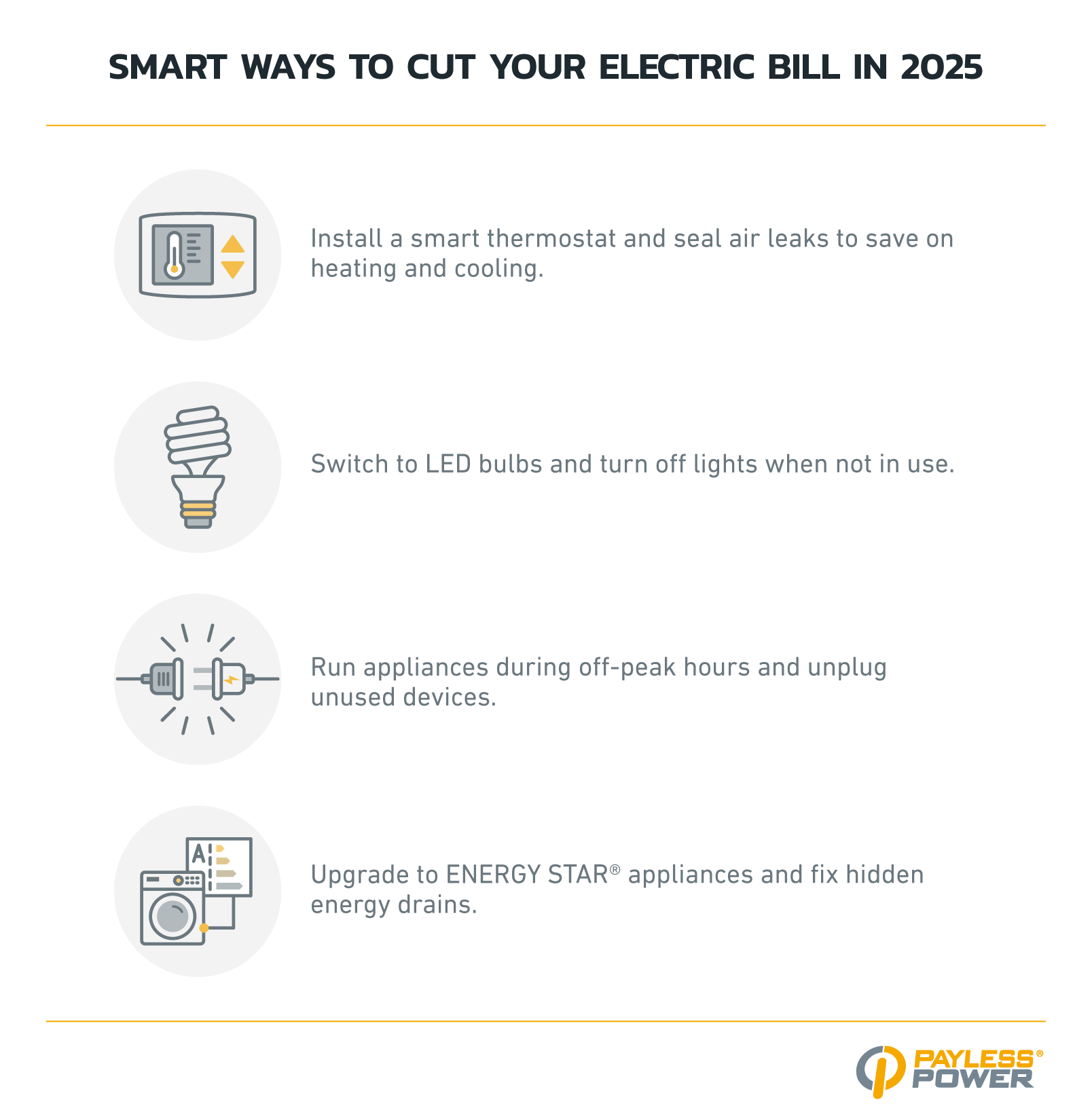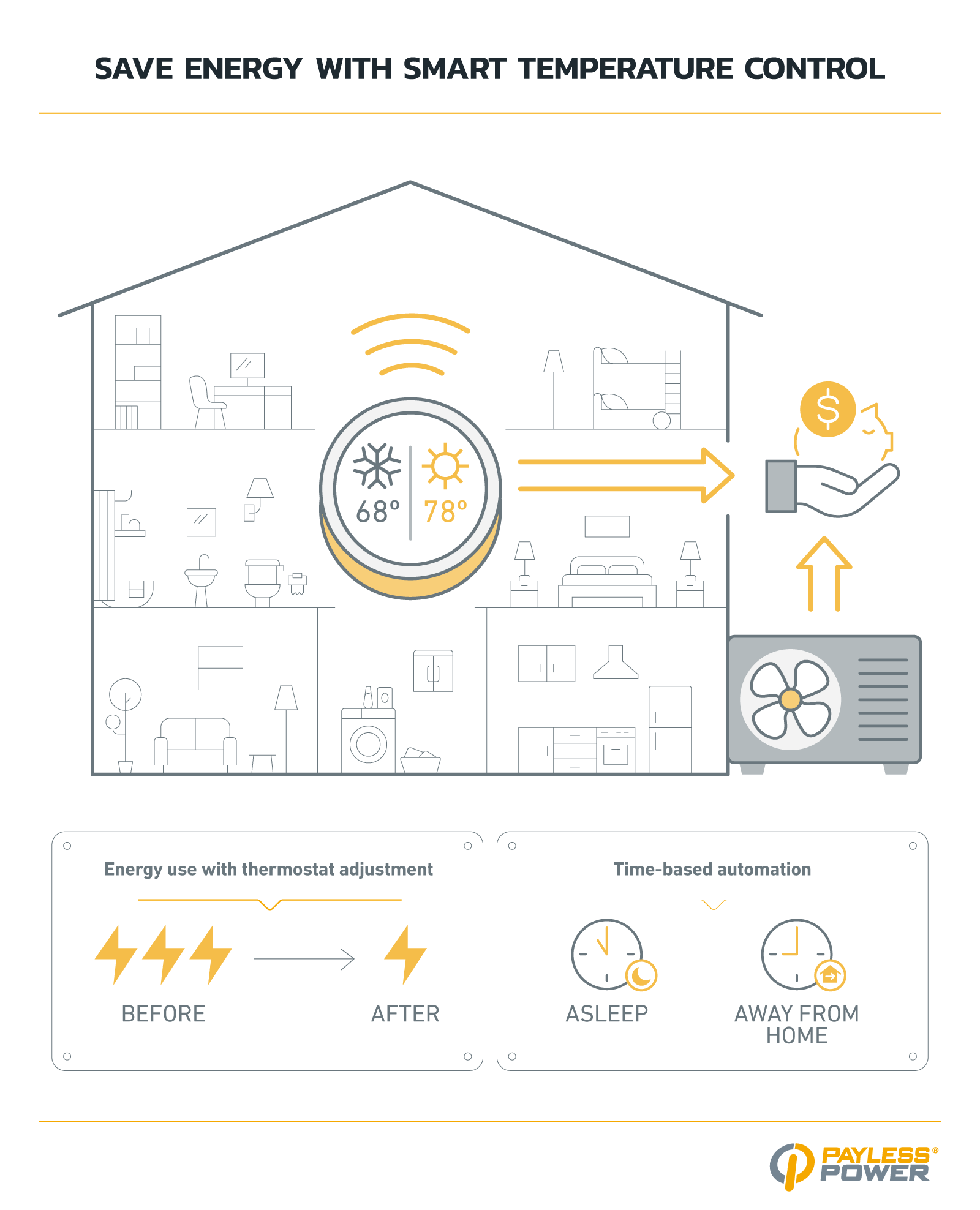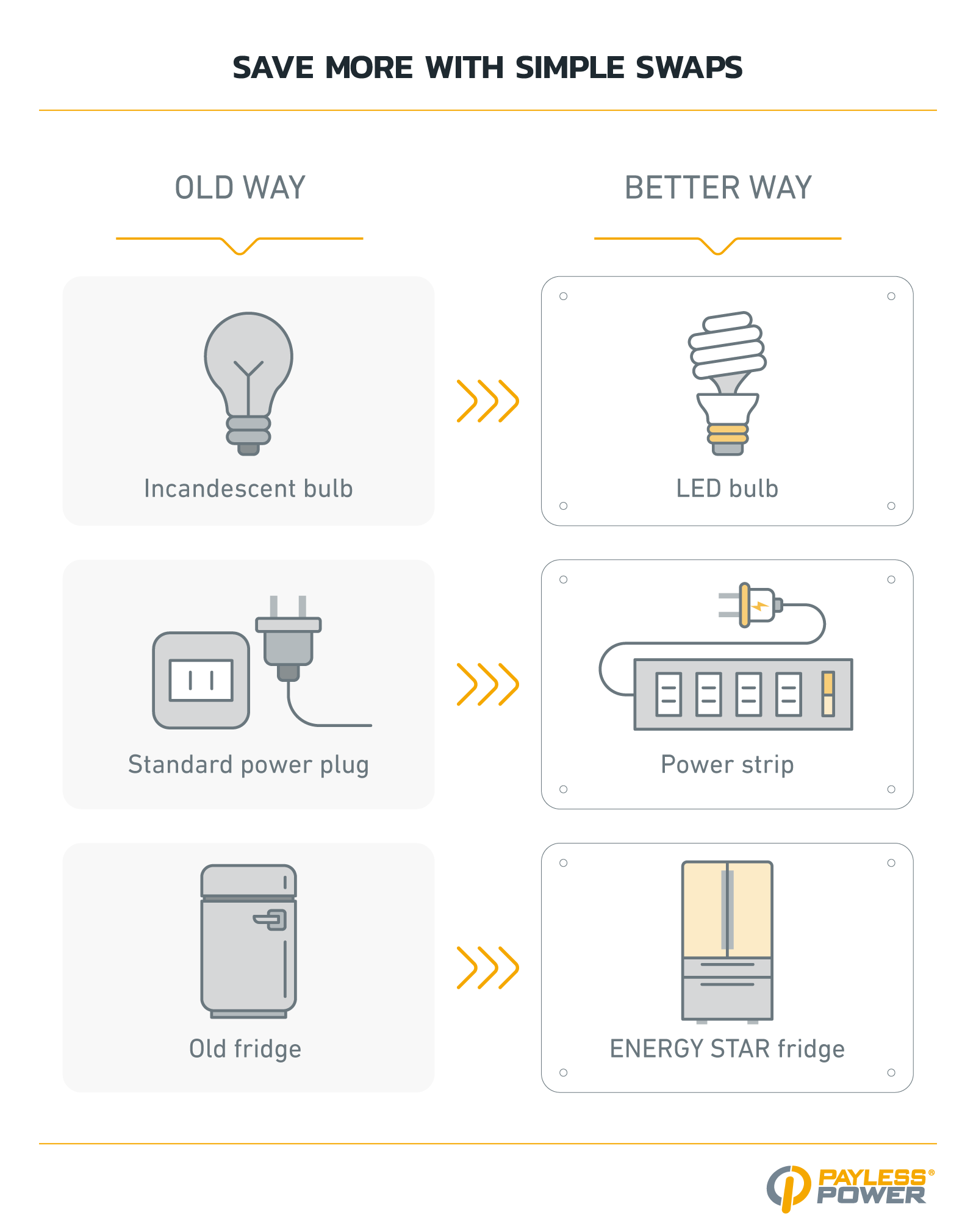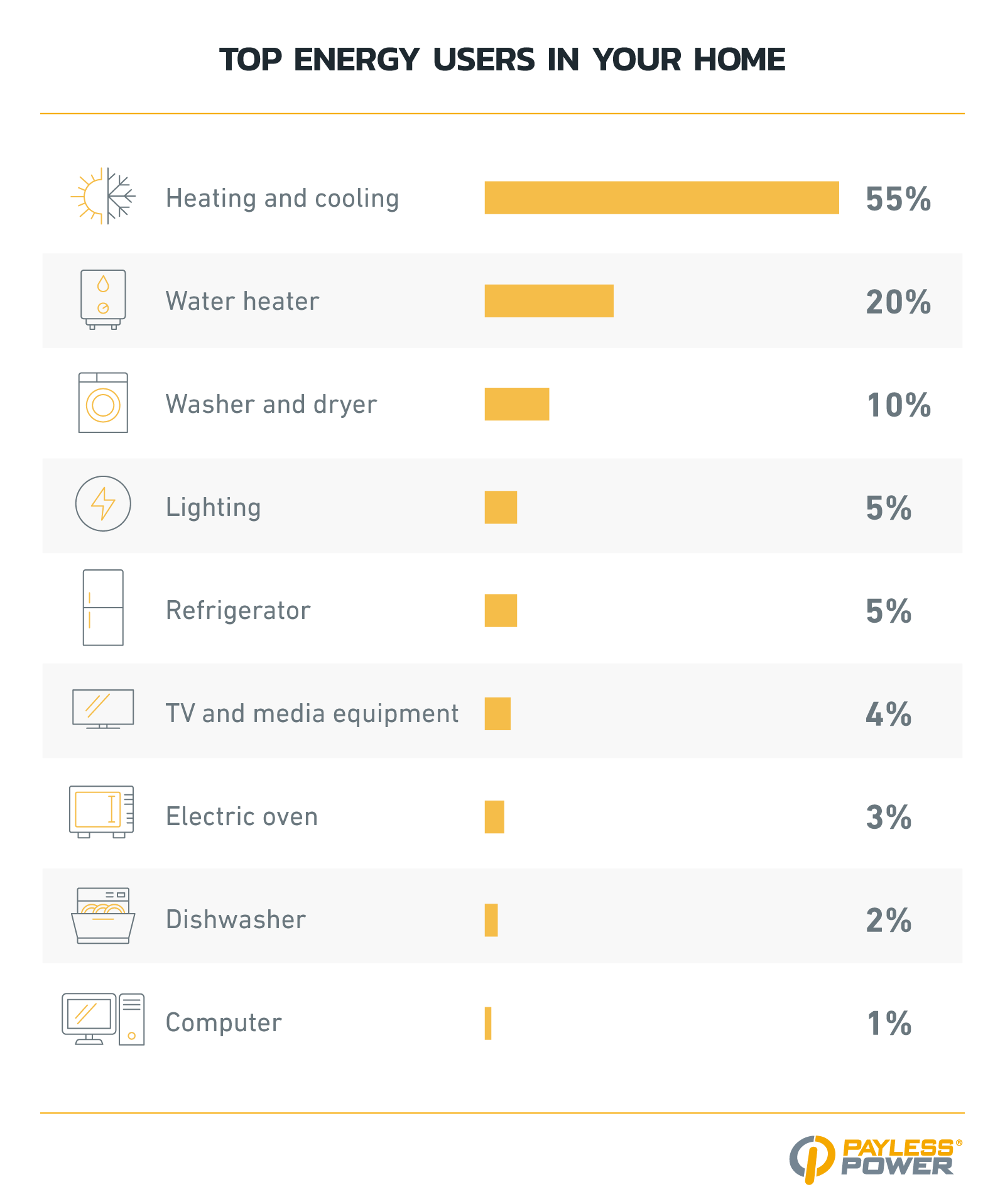The 2025 Energy-Saving Playbook: How To Reduce Your Bill Without Sacrificing Comfort
Tired of high electricity costs but not ready to sacrifice comfort? You’re not alone: U.S. consumers waste nearly $300 billion per year in energy, and energy costs have risen to seven times the average household income since 2004.
Fortunately, there are simple, cost-effective, energy-saving tips that homeowners can start using right away to reduce their electricity usage and lower their electric bill — without investing in major upgrades. From adjusting daily habits to making small, energy-efficient changes around the house, saving energy is easier and more practical than many people think. In this guide, you’ll learn how to cut back on energy consumption, manage your electricity use more efficiently, and understand the long-term benefits of saving energy for both your wallet and the environment.
Smart Thermostats and Temperature Control
Installing a programmable thermostat or smart thermostat is one of the most effective ways to reduce energy usage while keeping your home comfortable. These devices allow you to automate heating and cooling schedules so your HVAC system isn’t running when it’s not needed — like when you’re at work or asleep. By maintaining consistent temperatures and adjusting settings based on your habits, you can significantly cut heating costs in the winter and cooling costs in the summer, all while creating a more energy-efficient home environment.
Cut Heating and Cooling Waste With Proper Weatherization
About 30% of all energy used in buildings goes to waste or could be used more efficiently. So, sealing your home against drafts is one of the easiest and most effective ways to reduce energy usage and lower your energy costs year-round. Whether you’re trying to keep warm air inside during the winter or block it out during a hot Texas summer, minimizing air leaks helps your HVAC system run more efficiently.
Here are a few practical weatherization tips that can help weatherize your home and lower your electric bill in Texas:
- Apply weather stripping. Use it around doors and windows to prevent outdoor air from seeping in and conditioned air from escaping.
- Seal gaps with caulk. Fill in cracks and small openings along baseboards, windows, and exterior walls to reduce heat loss.
- Check and close the damper. When your fireplace isn’t in use, keeping the damper closed prevents unnecessary drafts.
These simple steps can go a long way toward cutting energy waste and keeping your home comfortable in any season.
Lighting Tips To Lower Your Electricity Costs
Improving your lighting habits is a quick and affordable way to reduce electricity usage, save electricity at home, and make your home more energy-efficient. Outdated lighting can quietly drive up your energy bill, but a few simple changes can lead to long-term savings.
Try these tips to save energy with lighting:
- Switch to LED bulbs. CFLs use 75% less energy than incandescent light bulbs. Replacing traditional incandescent bulbs with LED light options can reduce lighting-related electricity usage by up to 75%.
- Remove incandescent bulbs. Incandescent bulbs use more energy and burn out faster than energy-efficient alternatives.
- Turn off lights when not in use. Making it a habit to switch off lights in unoccupied rooms helps lower your electric bill.
- Use task lighting. Focusing light only where you need it — like in workspaces or reading areas — can conserve energy without sacrificing comfort.
Save With Your Washer and Dryer
Laundry is one of the most routine energy-using tasks in any home. Improving how you use your washing machine and clothes dryer can help you save electricity at home and cut back on unnecessary electricity usage.
Try these smart laundry tips to get started:
- Wash clothes with cold water. Heating water uses significantly more energy than cold cycles, and cold water is effective for most loads.
- Run full loads. Using your washer and dryer only when you have a full load makes each cycle more energy-efficient.
- Clean the lint filter. A clogged lint trap reduces airflow and forces your dryer to use more energy to get the job done.
- Air-dry when possible. Hanging clothes to dry saves energy and reduces wear and tear on fabrics.
Hot Water Efficiency Tips
Hot water use is a major contributor to energy consumption in most homes. With a few upgrades and smarter habits, you can reduce your energy use while still enjoying hot showers and clean dishes.
Try these tips to conserve energy and improve hot water efficiency:
- Lower the temperature on your water heater. Reducing it to 120°F is often enough and helps lower your electric bill.
- Install low-flow showerheads. These reduce the amount of hot water you use without compromising comfort.
- Fix leaks quickly. Even a slow drip from a hot water faucet wastes both water and the energy used to heat it.
- Upgrade to an energy-efficient hot water heater. Newer models use less energy and provide better performance.
Appliance Upgrades and ENERGY STAR® Choices
Older appliances can be some of the biggest energy users in your home. In fact, understanding what uses the most electricity can help you identify which upgrades will have the greatest impact. Replacing outdated models with energy-efficient, ENERGY STAR®–rated options helps reduce energy consumption and keeps your utility bills in check.
Start by focusing on these upgrades:
- Choose ENERGY STAR appliances. These models are certified to use less energy while maintaining strong performance.
- Replace old refrigerators or dishwashers. These are often among the appliances that use the most electricity and can be major sources of waste. Up to 30% of the cold air in your fridge escapes every time you open the door, so consider an option with clear doors, or be more mindful of how long you keep the door open.
- Upgrade your washing machine. Modern washers use significantly less water and energy per load than older units.
- Be mindful of how you use appliances. Powering down or unplugging devices when not in use helps eliminate unnecessary energy draw.
What Uses the Most Electricity in Your Home?
For more insight, take a look at some things that use more energy than others in a home to guide your decisions on what to replace first. The following appliance types are listed in order of how much of a home’s energy they consume, followed by tips to reduce it:
- Heating and cooling (55%). HVAC systems use the most electricity in a home. Reduce usage with smart thermostats, layering in winter, and fans in summer.
- Water heater (20%). Lower your heater’s temperature to 120°F, insulate the tank, and install low-flow fixtures to cut hot water energy use.
- Washer and dryer (10%). Wash with cold water, clean the lint trap, and air-dry clothes when possible to save energy.
- Lighting (5%). Replace incandescent bulbs with LEDs or CFLs and turn off lights in empty rooms to reduce lighting costs.
- Refrigerator (5%). Upgrade to an ENERGY STAR® fridge, keep coils clean, and maintain proper temperature and airflow.
- TV and media equipment (4%). Use smart power strips, reduce screen brightness, and turn off devices to stop energy waste from standby power.
- Electric oven (3%). Use smaller appliances when possible, avoid preheating unnecessarily, and cook during cooler times of day.
- Dishwasher (2%). Run full loads during off-peak hours and turn off the heat-dry function to save electricity.
- Computer (1%). Choose laptops over desktops, use sleep mode, and unplug chargers to cut electricity use from electronics.
Adjust Your Habits for Off-Peak Hours
When you use electricity, it can be just as important as how much you use. Shifting energy-heavy tasks to off-peak hours — when demand is lower and rates may be cheaper — can help you reduce energy usage and lower your electric bill. If you live in an area with time-of-use pricing, this habit is especially valuable for managing energy costs over time.
Try these habits to save money during off-peak electricity hours and reduce your electricity usage:
- Run appliances at night. Use your dishwasher, washing machine, and dryer during off-peak hours to take advantage of lower rates.
- Charge devices wisely. Plug in phones, laptops, and other electronics overnight instead of during peak daytime hours.
- Use a power strip. Electronics like the toaster and TV continue to draw power in standby mode — shutting them off at the strip prevents wasted energy.
- Spread out energy use. Avoid using multiple high-energy appliances at the same time during peak hours.
Hidden Reasons Your Electric Bill Might Be Too High
If your electric bill has been climbing for reasons you can’t explain, your home may have hidden energy drains. From poor insulation to outdated systems, several often-overlooked issues could be driving up your electricity costs and energy usage.
Watch for these common problems that may be behind unusually high electric bills:
- Air leaks and poor insulation. Cracks around windows and doors lead to heat loss and force your HVAC system to work harder.
- Inefficient HVAC systems. An aging or poorly maintained system can burn more energy than necessary.
- Standby mode waste. Devices like microwaves, TVs, and gaming consoles continue to use electricity even when turned “off.” In fact, 75% of the electricity used in the average American home to power household electronics gets used when those devices are off.
- Lack of energy-saving habits. Skipping basic maintenance like cleaning your air filter or sealing gaps can quietly raise your electricity costs.
Addressing these issues can help you save energy and reduce long-term energy usage across your home.
Surprising Energy-Saving Facts & Stats
Implementing energy-efficient measures in your home can lead to substantial financial savings and increase your property’s value. Here are some compelling statistics that highlight the benefits of energy efficiency for homeowners:
- Enhanced property value: Homes with energy-efficient features sold for approximately 2.7% more than comparable homes without such features.
- Homebuyer preferences: A significant 90% of homebuyers prefer purchasing a home with energy-efficient features, even if it means a higher upfront cost.
- Tax incentives utilization: In 2023, over 3.4 million American families claimed more than $8 billion in tax credits for clean energy and energy efficiency home improvements, averaging about $2,352 per household.
- Smart thermostat adoption: The U.S. smart thermostat market is projected to grow from $1.27 billion in 2022 to $3.86 billion by 2029, reflecting a growing trend among homeowners to invest in energy-saving technologies.
These statistics underscore the tangible benefits of adopting energy-efficient practices and technologies, from financial savings to increased property value and environmental impact.
Bonus Tips by Season and Situation
Energy-saving needs change depending on the time of year, your living situation, or even your daily routine. Whether you’re managing electricity usage in a small apartment or trying to lower utility bills during extreme weather, customized strategies can make a big difference. These resources offer targeted energy-saving tips to help you save on electricity in any scenario.
Energy-Saving Tips for Apartment Dwellers
In smaller spaces, managing energy use can be both easier and trickier. With limited control over insulation or appliances, small changes make a big impact:
- Use draft stoppers to seal leaky doors or windows.
- Unplug electronics when not in use to eliminate phantom loads.
- Make use of natural light during the day and avoid overhead lights when possible.
Wintertime Energy-Saving Strategies
Cold weather drives up heating bills, but smart energy habits can reduce costs without sacrificing comfort:
- Keep curtains open during the day to bring in natural heat.
- Lower your thermostat by a few degrees and wear warm layers.
- Insulate windows with thermal film or heavy drapes.
Summertime Energy-Saving Strategies
As temperatures rise, so does energy usage from air conditioning. Cooling your home efficiently can help reduce electricity bills:
- Set your thermostat to 78°F when at home and higher when away.
- Use ceiling fans to circulate cool air.
- Avoid using heat-generating appliances like ovens during the hottest parts of the day.
Holiday-Season Energy-Saving Strategies
Festive decorations and gatherings can drive up energy use. Stay efficient without sacrificing the cheer:
- Choose LED holiday lights and set them on timers.
- Cook multiple dishes at once to maximize oven use.
- Turn down the thermostat during parties — extra people mean extra heat.
How To Save Energy Despite Unpredictable Weather
Sudden temperature swings can wreak havoc on energy bills. Prepare your home for fluctuations:
- Install a smart thermostat to adjust temperatures automatically.
- Keep weather stripping in good condition year-round.
- Check your HVAC filters monthly for efficiency.
How To Save on Prepaid Electricity
Prepaid electricity users can take proactive steps to keep balances steady:
- Track daily usage to understand peak times.
- Set energy-saving goals and monitor progress.
- Use appliances during off-peak hours if your plan allows.
Work-from-Home Energy-Saving Tips
Being home all day means more energy use, but also more control over how it’s used:
- Turn off lights in unused rooms.
- Use energy-efficient power strips for home office equipment.
- Take breaks outdoors to reduce lighting and climate control needs.
Energy-Saving Tips for Schools
Schools are energy-intensive environments, but there are ways to reduce waste:
- Schedule regular maintenance for HVAC systems.
- Install motion sensors for lights in classrooms.
- Encourage students and staff to power down electronics.
Tips for an Energy-Efficient Attic
Your attic plays a major role in your home’s temperature regulation. Keep it in top shape to save on energy.
- Make sure your attic is properly insulated.
- Seal any air leaks around vents or openings.
- Consider adding a solar attic fan to improve airflow.
Winter Home Efficiency Upgrades
Investing in upgrades before or during winter can lead to long-term savings:
- Upgrade to energy-efficient windows and doors.
- Add insulation to walls, attics, and basements.
- Install a programmable thermostat for better temperature control.
Prepaid Electricity Bill-Lowering Tips
Cutting prepaid costs doesn’t require sacrifice — just smarter usage:
- Adjust your thermostat based on occupancy and time of day.
- Wash clothes in cold water and hang dry when possible.
- Replace old bulbs with LEDs to lower lighting costs.
Energy-Saving Tips for Kids
Teaching kids about energy use sets lifelong habits. Make it fun and engaging:
- Challenge kids to turn off lights and devices when not in use.
- Involve them in setting and reaching family energy-saving goals.
- Use games or charts to track energy-saving actions.
Vacation Settings To Reduce Energy Use
Don’t let your home waste energy while you’re away. Prepare your space before leaving:
- Set your thermostat to 85°F or turn it off if safe.
- Unplug electronics and nonessential appliances.
- Use timers for outdoor lights if needed for security.
Energy Tips for New Homeowners in the Fall
Fall is the perfect season to prep your home for energy efficiency:
- Schedule HVAC maintenance before winter.
- Seal any cracks or gaps to prevent heat loss.
- Install a smart thermostat for seasonal transitions.
Take Control of Your Energy Use in 2025
Reducing electricity costs doesn’t have to mean cutting comfort. As this playbook shows, homeowners can make a real impact by making smart upgrades, adjusting everyday habits, and being proactive about energy efficiency. From installing a smart thermostat to washing clothes with cold water and sealing air leaks, even small changes can lead to noticeable savings. With options for every season, home type, and lifestyle, the tools to save on electricity are more accessible than ever.
Understanding how and when you use electricity gives you the power to make meaningful changes. And by doing so, you’re not just cutting costs — you’re contributing to a more sustainable future.
Make 2025 the year you take control of your electricity costs. Explore flexible, affordable energy plans from Payless Power and start saving today.
What our customers are saying
See why our power customers say we're the best electricity provider in Texas!
I was worried about getting electricity for my home through a prepaid company. I was calling around to see different rates then going through all the hassle of credit checks while dropping points each…
I have been with this company for several years and have been very happy since. Even when I moved, they made my usually stressful situation very easy and carefree. I recommend them to everyone that I…
I have enjoyed the service for 2 years now. In the beginning this service was planned to be temporary but with the service being so effective for me i decided to keep it for the long haul. I’m a happy customer.


